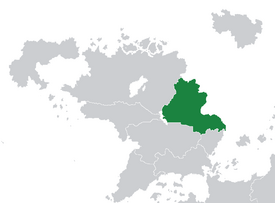Chistovodia
This article is incomplete because it is pending further input from participants, or it is a work-in-progress by one author. Please comment on this article's talk page to share your input, comments and questions. Note: To contribute to this article, you may need to seek help from the author(s) of this page. |
Chistovodian Workers' State Робоча Держава Чистовод'я Roboča Deržava Čystovodja | |
|---|---|
Motto: "Пролетарии всех стран, соединяйтесь!" "Workers of the world, unite!" | |
Anthem: The Internationale | |
 Chistovodia (dark green) in Asteria Superior (grey) | |
| Capital | Misto Myru |
| Largest city | Khmelnytskyi |
| Official languages | Narodyn |
| Ethnic groups | Chistovodians ~ |
| Demonym(s) | Chistovodian |
| Government | Federal semi-presidential council republic. |
• President of the Presidium | Viktor Martynenko |
• Premier | Angelika Cuvillier |
| Legislature | General Congress |
| History | |
• Colonisation | 1691 |
• Narozalic Civil War | 1856 |
• Independence | 1860 |
• Revolution | 1931 |
| Area | |
• | 2,399,981 km2 (926,638 sq mi) |
| Population | |
• 2015 estimate | 61,109,847 |
• Density | 25.46/km2 (65.9/sq mi) |
| GDP (nominal) | 2015 estimate |
• Per capita | $34,800 ($2.126tn.) |
| Gini (2014) | 22.1 low |
| HDI | 0.900 very high |
| Currency | Chistovodian Zolota (CZ) |
| Time zone | East Asterian Standard Time |
| Date format | dd-mm-yy |
| Driving side | right |
Chistovodia (Narodyn: Чистово́д'я, tr. Čystovodja), officially the Chistovodian Workers' State (Narodyn: Робоча Держава Чистовод'я, tr. Roboča Deržava Čystovodja) is a sovereign state in Asteria Superior. It borders Cassier to the north and Halland and Nuxica to the west, as well as having maritime borders with Narozalica and Gaullica. With a total area of 2,399,981 km2 and a population of over 61 million people, Chistovodia is one of the larger states in Asteria Superior. Its capital is the planned, central and coastal city of Misto Myru, whilst the largest and first founded city is Khmelnytskyi on the northern coast.
The area that is now Chistovodia was inhabited by multiple native peoples, including the Pueblo Nations and the Sioux. Eucleans initially arrived by the beginning of the 16th century. These were mainly Narodyn loggers, fur trappers and fisherman who were operating out of George Ruset Land, though the internal areas around Lake Mantowic were explored by east Euclean traders and navigators around the same time. By 1691 however, Narodyns had founded a major settlement -- what is now Khmelnytskyi.
Chistovodia remained the key colony of the Narozalic Empire up until the First Narozalic Civil War. The colony was a key supplier of arms, supplies, resources and veterans to the Seven Province Union and negotiated with Eduard Olsov to secure independence following the war. This was not honoured however and the threat of a secessionist war eventually forced Olsov, now President of Narozalica, into accepting their demands for independence by 1865. For much of its early independence history, up until the mid 1920s, Chistovodia was ruled by a military junta led by Vadym Babych. Babych, initially a progressive, industrialist and modernising ruler eventually deteriorated into a paranoid tyrant and led the now expanding population of the nation into destitution and poverty. By the time of the Great War Chistovodia was arguably one of the poorest nations in Asteria Superior and fell into a civil war involving numerous factions. The victors of this civil war were the Chistovodian Section of the Workers' International, who would go on to mould the state on the lines of a Kirenian Model.
In the modern day Chistovodia is a highly developed industrial economy with a large immigrant population. It scores highly in wealth equality, healthcare, life expectancy and government transparency. Chistovodia is also a nuclear weapons state that also has mandatory military service for up to a year. The nation is also criticised for an overly militaristic diplomatic relationship with neighbouring countries, such as Nuxica. This stems from the grievances of the historic conflict in the late 1970s. Recently, Chistovodian politicians have made it vocal that they view the territory annexed by Nuxica to be under illegal occupation.
